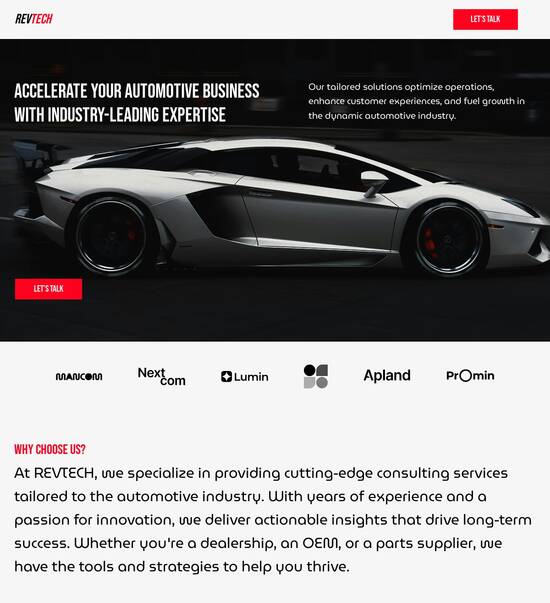
Laravel optimized reservation page template
Explore Similar TemplatesAbout template
Supercharge your reservation page with Laravel for outstanding performance! Learn more today.
Recommended templates

Easy to build without coding
With the intuitive drag-and-drop builder, anyone on your team can create high-converting pages without any knowledge of code or design. Make enhancements to your landing page with custom widgets using Javascript, HTML/CSS, or third-party scripts.

Multiple layouts for any industry and goal
Select from 500+ landing page layouts built to boost conversions across industry-specific scenarios. Customize them by adjusting fonts, adding images, and generating on-brand content with the AI assistant. Quickly scale with Instablocks® and Global Blocks that you can save, reuse, and update globally.

Loads fast and looks polished on any device
Every template is responsive, which means they present professionally on any device and load blazingly fast with our Thor Render Engine. You can also power them up with Google AMP technology to deliver an unparalleled mobile experience and drive higher conversions.

Robust analytics & experimentation
Get real-time updates and reporting across all your devices, showing the number of visitors, conversions, cost-per-visitor, and cost-per-lead. Launch AI-powered experiments, run A/B tests, and use heatmaps to analyze user behavior, then optimize your landing page to maximize conversions.







Easy to build without coding
With the intuitive drag-and-drop builder, anyone on your team can create high-converting pages without any knowledge of code or design. Make enhancements to your landing page with custom widgets using Javascript, HTML/CSS, or third-party scripts.
Multiple layouts for any industry and goal
Select from 500+ landing page layouts built to boost conversions across industry-specific scenarios. Customize them by adjusting fonts, adding images, and generating on-brand content with the AI assistant. Quickly scale with Instablocks® and Global Blocks that you can save, reuse, and update globally.
Loads fast and looks polished on any device
Every template is responsive, which means they present professionally on any device and load blazingly fast with our Thor Render Engine.
Robust analytics & experimentation
Get real-time updates and reporting across all your devices, showing the number of visitors, conversions, cost-per-visitor, and cost-per-lead. Launch AI-powered experiments, run A/B tests, and use heatmaps to analyze user behavior, then optimize your landing page to maximize conversions.
All the features you need to build lead-generating landing pages
Explore more featuresLearn how to build top-performing landing pages for any goal
FAQs
Leading the way in building high-performing landing pages





A comprehensive guide on using Instapage for optimizing landing pages
Optimizing your landing pages is crucial for enhancing the effectiveness of your digital marketing campaigns. Instapage is the leading platform that enables marketers to easily create and customize landing pages that drive conversions and engagement. In this guide, we will walk you through the step-by-step process of leveraging Instapage's powerful features to build high-performing landing pages.
Understanding Instapage's features
Instapage equips marketers with essential tools to design, optimize, and launch landing pages effortlessly. The platform offers over 100 high-converting templates and intuitive builders, allowing for quick customization without any coding experience. Additionally, its built-in optimization capabilities help ensure that your pages are designed to convert effectively.
- 100+ templates: Choose from a wide variety of pre-designed templates tailored for different industries, enhancing speed and efficiency in your campaign launches.
- Intuitive page builder: Easily customize layouts with drag-and-drop functionality, which allows you to focus more on design and less on technical hurdles.
- Experimentation tools: Conduct A/B tests seamlessly to experiment with different variations of your landing pages and find out what works best.
Step 1: Create a landing page
Begin by selecting a template that aligns with your campaign goals. Use Instablocks to tailor specific sections of your landing page according to your brand's needs. This flexibility is key to producing pages that not only attract but also retain user interest.
- Select your template: Use the first preview option to pick a template that resonates with your audience.
- Customize with Instablocks: Adjust sections to include your branding elements or messaging.
- Add lead generation tools: Include forms, CTAs, and other elements to optimize for conversions.
Step 2: Optimize for conversions
Once your landing page is created, utilize Instapage’s optimization tools to analyze its performance. This includes heatmaps that visualize user behavior and analytics to track engagement levels. Make adjustments based on data-driven decisions to enhance overall effectiveness.
- Use heatmaps: Understand where users are clicking to refine your layout and design.
- Implement A/B testing: Regularly test variations of your landing page to discover the most effective elements.
- Monitor analytics: Review key metrics like bounce rates and session duration to gauge and improve performance.
Step 3: Personalize user experiences
Personalization is essential in today’s digital landscape. Instapage provides dynamic content delivery options, allowing you to present tailored messaging based on audience segments. This personalized approach can significantly increase engagement and conversion rates.
- Dynamic text replacement: Automatically swap out keywords or phrases to match user intent.
- AdMaps integration: Direct specific advertising campaigns to tailored landing pages, ensuring a cohesive experience.
- Audience-level tracking: Measure the effectiveness of your personalized strategies on different audience segments.
By following these steps, using Instapage will empower you to not only create functional landing pages but also optimize them continually for higher conversion rates.
Ready to transform your marketing efforts? Start using Instapage today to unlock your campaign's full potential and maximize ROI with expertly designed landing pages.
Creating a Laravel optimized reservation page template
Defining the Laravel optimized reservation page template
Laravel is a powerful PHP framework designed for building web applications quickly and efficiently. It streamlines the development process with a robust architecture, offering tools like Eloquent ORM and Blade templating. Developers often choose Laravel for its elegant syntax and vibrant community, making it an excellent choice for modern web development projects.
Reservation systems play a crucial role in various industries such as hospitality, healthcare, and event management. They allow users to book services or make inquiries seamlessly, improving customer satisfaction. As users increasingly turn to online solutions, having an optimized reservation system becomes fundamental to maintaining a competitive edge.
An optimized reservation page template in Laravel serves as a starting point for developers, offering pre-built functionalities that streamline the booking process. This template incorporates user-friendly designs and backend integrations, enabling users to navigate easily and complete reservations with minimal friction.
Key features of the Laravel optimized reservation page template
A primary hallmark of an effective reservation page template is a user-friendly interface. Intuitive design principles guide the layout, ensuring that users have a pleasant experience while navigating. For layouts, developers can choose between grid and list options depending on how they wish to display information. A grid layout is visually appealing and allows users to compare different options side-by-side, while a list layout is better for detailed inquiries.
User-friendly design improves navigation and reduces drop-off rates.
Grid layouts showcase multiple offerings amplifying user choices.
List layouts offer detailed insights about specific services.
Real-time availability checks are another critical feature of the template, ensuring users have up-to-the-minute information on open slots. Technologies like AJAX and WebSockets can be utilized here, drastically improving user experience by removing the need for frequent page reloads. The user interaction flow should allow users to see available times effortlessly, driving conversions.
AJAX provides seamless updates without refreshing the page.
WebSockets enable real-time communication for instant notifications.
Multi-location support is advantageous for businesses operating in various regions. Incorporating dynamic location selection tools allows users to see availability based on their preferred location, enhancing personalization. This feature streamlines the booking process for users, enabling a more effective experience.
Dynamic location selection enhances user experience and adaptability.
Improves efficiency for businesses with multiple locations.
A customizable user experience is an integral part of the Laravel optimized reservation template. By tailoring templates for specific industries, developers can ensure that each template speaks directly to target audiences. Additionally, offering personalization options enhances user engagement and satisfaction, making users feel more connected to the services offered.
Industry-specific templates resonate better with target audiences.
Personalized options improve engagement and user retention.
Finally, mobile optimization cannot be overlooked. The growing reliance on mobile devices to complete transactions necessitates that reservation templates be designed with accessibility in mind. Responsive design enhancements ensure that pages display correctly across various devices, creating a cohesive user experience.
Accessibility increases reach, catering to diverse user preferences.
Responsive designs adjust automatically for an optimal viewing experience.
Integrating backend technologies
The robust MVC architecture of Laravel plays an essential role in developing an optimized reservation page template. Models, Views, and Controllers work harmoniously to facilitate clean separation between application logic and presentation, ensuring efficient data handling. This concept allows developers to build features that are both scalable and maintainable, adhering to best coding practices.
Utilizing Laravel's Eloquent ORM for database management provides an efficient way to manage reservations. Eloquent makes it simple to interact with the database, abstracting away complex SQL queries with easy-to-understand methods. Schema design tailored for scalability ensures that as user bookings increase, the system remains responsive and efficient.
Eloquent ORM simplifies complex queries, enhancing productivity.
Well-structured schema helps scale systems effectively.
Integrating APIs allows the reservation system to leverage external services, such as payment processors and calendar bookings. RESTful APIs are essential to building mobile-friendly applications where reservations can be made on-the-go. This integration enhances user experience significantly, giving users flexibility and freedom in managing their bookings.
APIs facilitate communication between different software systems.
Mobile accessibility boosts user interaction and increases bookings.
Engaging communities for optimal development
Collaborating with the Laravel community can significantly improve the development process for reservation templates. Engaging with open-source contributions fosters an environment of shared knowledge and resources, allowing developers to access a wealth of experience and solutions to common challenges. Online forums, such as Laracasts and the Laravel subreddit, provide platforms for developers to ask questions, share insights, and receive feedback.
Open-source contributions enhance collaborative learning.
Access to a broader community leads to faster problem resolution.
Knowledge sharing within the community can be expanded through extensive documentation and best practices. Engaging in workshops and meetups allows developers to connect with peers, facilitating discussions on recent trends, pain points, and effective development strategies. This ongoing learning process is vital to staying relevant in the ever-evolving tech landscape.
Workshops offer hands-on experiences that can deepen understanding.
Networking during meetups builds lasting connections within the industry.
Developing reservation features: A deep dive
Effective reservation management starts with implementing various methods for collecting reservations. These can include online forms, phone bookings, or integrations with third-party applications. Offering different booking channels caters to diverse user preferences, improving overall satisfaction. Additionally, providing an admin dashboard allows team members to manage reservations efficiently, streamlining the process.
Flexible booking methods cater to a broader audience.
Admin dashboards provide essential tools for managing bookings.
Users often have questions during the booking process, making it essential to handle inquiries effectively. Integrating a Q&A section allows users to find answers quickly, while AI-assisted responses for common questions can enhance this feature. By using chatbots and automation, businesses can provide timely assistance, thereby increasing user confidence.
AI-assisted responses improve response times for user inquiries.
Integrated chatbots facilitate user engagement.
Setting up notifications and reminders is crucial in maintaining customer engagement. By sending email and SMS alerts for upcoming reservations, businesses can ensure users remember their bookings. Follow-up communications not only keep users informed but can also elicit feedback, ultimately leading to improvements in service offerings.
Alerts keep users informed about their reservations.
Follow-ups encourage feedback for service improvement.
Building previews and testing
Creating live previews of the reservation process is vital for understanding how users interact with the booking system. Interactive components allow individuals to explore functionalities before committing to reservations. Soliciting user feedback during these testing phases ensures that developers can make necessary adjustments, fostering an environment of continual improvement.
Live previews provide insights into user experience.
User feedback leads to optimized designs that align with preferences.
Conducting A/B testing is another method to ensure the optimal performance of the reservation page template. Employing strategies for effective comparison, developers can analyze which features yield better user engagement and conversion rates. Monitoring user interaction metrics can provide valuable data for making informed decisions about design changes.
A/B testing identifies the most effective design elements.
User interaction metrics guide improvement strategies.
Case studies: Success stories with Laravel reservation templates
Different industries have successfully implemented Laravel reservation templates to streamline their operations. For instance, in the hospitality sector, hotels and restaurants have found that an optimized reservation system enables better management of bookings and increases customer satisfaction. By utilizing a tailored reservation page, establishments can present their services effectively, ultimately boosting reservations.
Hotels benefit from organized booking management and enhanced customer experiences.
Restaurants can maximize seating capacity through effective reservation systems.
In the services industry, businesses like salons and healthcare facilities have also adapted these templates for their specific needs. Transformation stories reveal how optimizing their reservation processes led to measurable success in efficiency and user satisfaction. For example, salons using an effective scheduling system reported less overbooking and smoother service management.
Salons experience improved client management with streamlined bookings.
Healthcare organizations see reduced scheduling conflicts with optimized systems.
Future trends in reservation templates
Looking forward, the rise of AI and machine learning will shape the landscape of reservation templates. By predicting user behavior and preferences, businesses can offer personalized recommendations that enhance user experiences. These technologies can automate customer interactions, addressing inquiries promptly, and significantly boosting user engagement.
AI-driven predictions enhance the personalization of services.
Automation can streamline customer interactions, improving satisfaction.
Augmented reality (AR) is another emerging trend that can revolutionize the way users interact with reservation pages. Virtual tours of facilities can help users visualize experiences before making reservations. By providing immersive content, businesses can increase user interest and ultimately drive conversion rates.
AR enhances user engagement by offering immersive pre-reservation experiences.
Visual content can significantly influence booking decisions.
Best practices for maintaining a Laravel reservation page template
Maintaining a Laravel reservation page template requires commitment to regular updates and security enhancements. It's essential to keep Laravel updated to leverage new features and security patches. Addressing vulnerabilities promptly minimizes risks and ensures user data is protected, significantly enhancing trust and brand loyalty.
Regular updates safeguard against potential security threats.
Timely patches maintain user trust and protect sensitive data.
Collecting user feedback is essential for continuous improvement of the reservation system. Utilizing surveys and feedback forms offers invaluable insights into user experiences, while implementing user suggestions can lead to significant enhancements. This feedback loop ensures that the template evolves to meet user expectations and industry standards.
User surveys can reveal pain points and areas for improvement.
Acting on feedback cultivates user satisfaction and loyalty.
Leveraging data analytics for reservation insights
Tracking metrics is essential for fostering a culture of continuous improvement in reservation processes. Key performance indicators (KPIs), such as booking rates, abandonment rates, and customer satisfaction scores, provide insights into the effectiveness of the reservation template. Analyzing these metrics helps businesses identify what works well and where adjustments are needed.
KPIs offer measurable insights into system performance.
Data-driven decisions enhance service delivery based on identified strengths.
Using data analytics also enhances community engagement. By understanding user preferences, businesses can tailor marketing efforts to resonate with their target audience. This informed approach not only improves user experience but also drives higher conversion rates and deeper brand loyalty.
Engaging with user preferences leads to more effective marketing strategies.
Personalized experiences encourage user loyalty and repeat bookings.
Ready to skyrocket conversions?
Supercharge your ad campaigns with high-performing landing pages
Get started














